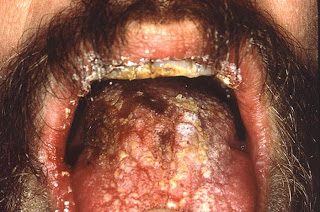Well, in today's post, I would delve into what yeast infection is into details. There is always a solution that can be found on this blog. I hope you take an act quickly to resolve this condition as I can say as a matter of my clinical experience how devastating it can be.
Alright, so let's begin.
 Patients with thrush esophagitis or oral thrush for that matter classically present with odynophagia, dysphagia and substernal chest pain. The severity of symptoms may range from mild swallowing difficulty to intense pain that prevents swallowing leading to dehydration and malnutrition. Patients who present with particularly severe pain should be worked up for alternate or coexisting diagnoses.
Patients with thrush esophagitis or oral thrush for that matter classically present with odynophagia, dysphagia and substernal chest pain. The severity of symptoms may range from mild swallowing difficulty to intense pain that prevents swallowing leading to dehydration and malnutrition. Patients who present with particularly severe pain should be worked up for alternate or coexisting diagnoses.
Physical examination of patients with AIDS may reveal oral thrush or candidiasis. Two thirds of AIDS patients with oral thrush and symptoms of esophagitis have candida esophagitis. In patients with chronic mucocutaneous candidiasis, fungal infections of other mucosa surfaces, hair, skin, and nails may be present. These patients may also have evidence of primary adrenal insufficiency, such as hyper-pigmentation or hypotension.
Barium, esophagram may reveal multiple plaque like lesions that occur in a linear or confluent fashion. Other findings that may be present include cobble stoning, nodules, fungal balls, strictures, ulcers, masses, or fistuals with in the pulmonary tree. A normal esophagram does not exclude candida esophagitis. In addition, the presence of a large ulcer should suggest an alternate diagnosis.
Blind cytology via an oral or nasal approach with brush or balloon technique in AIDS patients has been shown to be sensitive for diagnosis of candida esophagitis, but not for CMV or HSV esophagitis, which may coexist. Therefore, blind cytology is not an optimal test to determine all possible etiologies of esophagitis in a patient with AIDS.
Upper endoscopy with brush and biopsy has the highest sensitivity and specificity, and is the diagnostic method of choice. Findings during endoscopy include white to yellow colored plaques, which, on subsequent histologic examination, demonstrate epithelial, fungal, bacterial,and inflammatory cells. Ulcerations are rarely seen but may occur in neutropenic patients. Brushing usually provide a higher diagnostic value; preparation of biopsies for histologic examination may lead to loss of organisms thereby affecting the results.
General supportive therapy with intravenous hydration and nutritional support should be considered for patients who cannot eat or drink because of severe symptoms. In AIDA patients, use of highly active anti-retroviral therapy to increase the CD$ count results in clinical improvement.
Oral therapy primarily with the azole anti fungals and intravenous therapy, mainly with amphoterician B, are used in the treatment of candida esophagitis. Oral therapy is used for immuno-competent patients, and immuno-compromised patients without neutropenia who are able to tolerate oral feeding. Intravenous therapy is reserved for patients who cannot take medications by mouth, and neutropenic patients in whom the risk of disseminated candidiasis is high.
Specifically, immuno-competent patients, mildly immunocompromised patients and AIDS patients should all be treated with fluconazole at 100 mg given orally every day for 2 weeks, with a 200 mg loading dose given on day one. Studies have demonstrated this regimen to be superior to treatment with ketoconazole, and equivalent to itraconazole solution given at 200 mg p.o daily.
The advantages of fluconazole are non-pH dependent or meal dependent absorption, and its availability is intravenous or oral form. The major side effects of azole therapy are dose-dependent nausea and liver toxicity and inhibition of cyclosporin metabolism, an important concern when used in transplant patients.
Take time to review the best anti fungal creams we have selected just for you on the antifungal cream products at the top of this page to help you with oral thrush treatments.

No comments:
Post a Comment